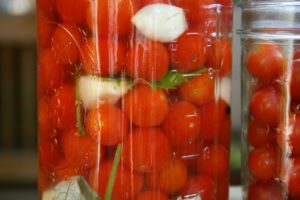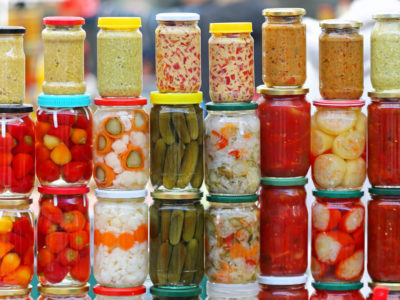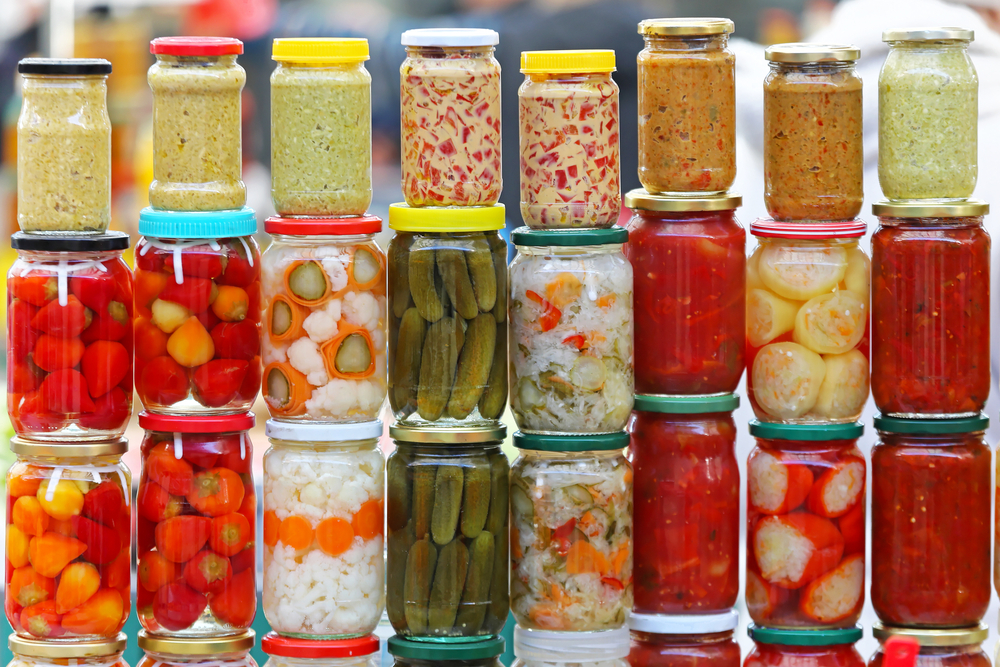Most of us are familiar with at least a handful of fermented foods (like sauerkraut or yogurt); but the history, variety, and benefits of fermentation are much more extensive than many people realize. In fact, over 5,000 types of fermented foods have been documented across the globe, and include nearly every edible thing you can think of—meats, fish, cereal products, legumes, vegetables, fruits, beverages, nuts, and seeds. Especially before refrigeration was widespread, fermentation was ridiculously useful for preserving food and extending the shelf life of perishable items. That’s why for thousands of years, populations around the world have used fermentation in their traditional cuisines.
Table of Contents[Hide][Show]
But, just because we have refrigerators now doesn’t mean fermentation isn’t still a valuable practice! In fact, fermented foods offer some amazing benefits that can’t be obtained from other nutrient-dense foods. Including them in your diet can be a major plus for your health (and not to mention, they’re delicious)!
What is Fermentation?
Fermentation is the process of biochemically modifying a food by using microorganisms and their enzymes. It is a type of preservation, allowing a food to be shelf-stable without rotting or degrading. Different types of bacteria (especially lactobacillus and acetobacter species), mold (including Penicillium species used for cheeses), and yeast (including the Saccharomyces family) are all used to produce different types of fermented foods. In contrast to food getting contaminated by pathogenic organisms (which is bad!), in the process of fermentation, only the “safe” microbes are involved!
Typically, when we talk about foods rich in probiotics, we’re referring to products that have been bacterially fermented. Mold fermentation can still create health-promoting foods, but it generally doesn’t supply the type of probiotic organisms that most benefit our guts. Some forms of yeast, especially in the Saccharomyces family, are also considered to have probiotic effects.
Probiotic Benefits of Fermented Foods
I’m sure you already know that I’m a BIG fan of probiotics (you can check out this excerpt from The Paleo Approach for a more detailed discussion). In a nutshell, probiotics are living microorganisms that are beneficial to the host that eats them (that’s us!). We don’t fully understand how they exert all of those benefits yet (partly because there are about 35,000 species of probiotic bacteria out there, only a tiny fraction of them have been characterized, and each strain seems to have a unique effect on the body). But, we can say with confidence that probiotics can have a profound effect on the immune system, can decrease the populations of less favorable bacteria in your gut (helping improve gut dysbiosis), and may directly and indirectly impact a number of health conditions—ranging from autoimmune diseases to obesity to diabetes.
When we consume fermented foods (raw, unpasteurized, and still teeming with friendly microbes), we get the benefits of these probiotics along with the additional micronutrients and helpful compounds found in whole foods. So, it’s no surprise that fermented foods have repeatedly turned up as protective in the scientific literature. Fermented dairy containing Lactobacillus bulgaricus and Streptococcus thermophilus has been shown to deactivate etiologic risk factors for colon cancer—increasing the excretion of components that harm colon cells and induce oxidized DNA bases. (Even if you’re sensitive to dairy, other foods fermented with lactobacillus strains may have a similar effect.) Foods fermented with Bifidobacteria have shown up as protective against gastrointestinal disorders. Studies of yeast-fermented foods containing the Saccharomyces family suggest they may reduce some symptoms of IBS. A variety of lactofermented foods have been linked to improved intestinal tract health, reduced symptoms of lactose intolerance, and reduced risk of certain cancers.
Need I say more? Fermented foods is a super easy, tasty way to get some amazing health benefits.
Types of Probiotics and Fermented Foods
As I mentioned, there are literally tens of thousands of probiotic species, and we’ve only scratched the surface in terms of characterizing them and researching their effects. But, a few main types of probiotics have been extensively studied, and their specific health effects are well documented (hint: it’s good news!):
Lactobacillus strains (rich in fermented veggies, dairy, and meats):
- In general, improves lactose digestion (and decreases symptoms of lactose intolerance) and boosts mucosal immune function (gut, lung, sinuses, etc.)
- Lactobacillus acidophilus can reduce serum cholesterol levels and protect against urogenital infection (phewf!); in animal models, decreases colon polyps, adenomas, and cancer
- Lactobacillus plantarum can reduce pain, constipation, bloating, flatulence, and inflammation in inflammatory bowel disorders
- Lactobacillus reuteri shortens episodes of diarrhea and acute gastroenteritis
- Lactobacillus rhamnosus can enhance cellular immunity
- Lactobacillus salivarius has been shown to suppress and eradicate pylori in animal models and tissue cultures
Bifidobacteria species (rich in fermented veggies, dairy, and meats):
- Can help prevent and treat gastrointestinal disorders such as colonic transit disorders, colonic adenomas, colon cancer, and intestinal infections
- May prevent or improve infectious diarrhea
- Tentative evidence of protective action against carcinogenic activity of intestinal flora
Saccharomyces boulardii (rich in kefir and kombucha, but also fermented veggies, dairy and soy):
- Reduces occurrence of difficile infection
- Reduces duration of acute gastroenteritis
- In irritable bowel syndrome, may decrease functional diarrhea
 Although probiotic supplementation can be useful in a lot of circumstances, you can actually get a much, much broader range of probiotics (including the ones above and the less-well characterized but still very beneficial ones) by eating fermented foods—which have a slightly different array of microbes in each batch. What can we load our plates with? Let’s start with some of these!
Although probiotic supplementation can be useful in a lot of circumstances, you can actually get a much, much broader range of probiotics (including the ones above and the less-well characterized but still very beneficial ones) by eating fermented foods—which have a slightly different array of microbes in each batch. What can we load our plates with? Let’s start with some of these!
- Raw, unpasteurized fermented vegetables (sauerkraut, kimchi, pickles, beets, carrots)
- Raw, unpasteurized, fermented fruits (chutneys, jams, green papaya, pickled jackfruit)
- Kombucha
- Raw, unpasteurized fermented condiments (“real” ketchup, relishes, salsas, pickled ginger)
- Water kefir
- Coconut milk kefir
- Coconut milk yogurt
- Beet kvass
- If you don’t have any specific restrictions on dairy: raw, unpasteurized yogurt or kefir
- If you don’t have any specific restrictions on soy: natto, miso, tempeh, and tamari sauce (fermented soy is also rich in vitamin K2; but keep in mind, fermentation doesn’t reduce the phytoestrogen content of soy foods, so these products will still contain very high levels of potential endocrine-disrupting chemicals)
High-quality fermented products are increasingly becoming available in grocery stores, but we can also reap the benefits by making your own. It’s not scary, I promise! Plenty of resources are out there, and to get you started, I recommend the books Fermented by Jill Ciciarelli (which I reviewed here) and Fermented Vegetables by Kirsten K. Shockey and Christopher Shockey (which is reviewed here). And, whether you’re new to and intimidated by fermented foods or a seasoned pro, you’ll love the Fearless Fermentation Online Video Classes and Community by Sarah Ramsden.
More Than Helpful Microbes: Nutrient Bioavailability, Conversions, and Preservation
While the probiotic content of fermented foods is reason enough for us to include them in our diets, fermentation offers a number of other perks too—and one is enhancing the bioavailability of nutrients. As a nutrient-geek, this excites me even more than the probiotic benefits!
 Bioavailability refers to the proportion of a nutrient contained within a specific food that gets digested, absorbed, and used/metabolized by your body. Cooking enhances the bioavailability of many fiber-bound foods, for example, by breaking down cellulose (the main component of plant cell walls) and making nutrients more accessible to your digestive enzymes. But, it just so happens that fermentation does something similar, without the nutrient destruction that comes from high temperatures or heavy processing! In fact, some probiotic microbes produce cellulase, an enzyme that degrades cellulose without even needing heat. Tomatoes illustrate this perfectly: cooking is known to increase the lycopene and beta-carotene content of tomatoes, but lactic acid fermentation has the same effect—increasing bioavailable lycopene from 3.70 to 5.68 mg per 100 grams, and beta-carotene from 0.28 or 0.89 mg to 1.14 mg per 100 grams, depending on the tomato variety.
Bioavailability refers to the proportion of a nutrient contained within a specific food that gets digested, absorbed, and used/metabolized by your body. Cooking enhances the bioavailability of many fiber-bound foods, for example, by breaking down cellulose (the main component of plant cell walls) and making nutrients more accessible to your digestive enzymes. But, it just so happens that fermentation does something similar, without the nutrient destruction that comes from high temperatures or heavy processing! In fact, some probiotic microbes produce cellulase, an enzyme that degrades cellulose without even needing heat. Tomatoes illustrate this perfectly: cooking is known to increase the lycopene and beta-carotene content of tomatoes, but lactic acid fermentation has the same effect—increasing bioavailable lycopene from 3.70 to 5.68 mg per 100 grams, and beta-carotene from 0.28 or 0.89 mg to 1.14 mg per 100 grams, depending on the tomato variety.
In their unprocessed state, many foods contain antinutrients that bind to minerals and inhibit their absorption. Phytates (antioxidant compounds found in grains, legumes, nuts, and seeds) are a common example, and their presence in food can limit absorption of iron, zinc, and manganese (and to a lesser extent, calcium). But, some microbes involved in fermentation can produce phytase enzymes, which hydrolyze phytate and grant your body greater access to the minerals in the food you’re eating. By some estimates, fermentation can remove at least 90% of existing phytate from corn, cassava, cowpeas, lima bean, sorghum, soybeans, and cocoyam. (As an added bonus, organic acids produced during fermentation (including citric acid, malic acid, and lactic acid) can potentially enhance mineral absorption as well, especially for iron and zinc.)
A similar effect happens with polyphenols—plant chemicals that are widely considered beneficial for their antioxidant properties, but that can also reduce the bioavailability of certain minerals. Because fermentation increases the acidity of food, it can create the optimal pH conditions for polyphenols to be enzymatically degraded. For example, a study on cocoa pods found that fermentation (done by piling cocoa beans between layers of banana leaves for six days) increased the beans’ copper content by about 100%, due in part to reducing levels of tannin—a type of polyphenol—that naturally occurs in cocoa.
 Along with increasing bioavailability, fermentation can actually convert some micronutrients into new forms that weren’t there originally. This happens through the process of biosynthesis, where certain bacteria help synthesize new beneficial compounds. A great example is the conversion of menaquinones (vitamin K2) by Bacillus subtilis, the strain of bacteria used to ferment natto (a traditional Japanese soybean product). Even though soybeans don’t contain vitamin K2 when they’re fresh out of the pod, fermentation with Bacillus subtilis causes the resulting product to be one of the highest sources of vitamin K2 out of any food in existence, due to it being synthesized by bacteria during fermentation. In fact, most of the Paleo rationale against eating soy is no longer valid once we start talking about these nutrient-dense more easily digested fermented versions of soy. If you don’t have an overt sensitivity to soy or sex hormone imbalances, you might find that natto or tempeh is a good addition to your diet.
Along with increasing bioavailability, fermentation can actually convert some micronutrients into new forms that weren’t there originally. This happens through the process of biosynthesis, where certain bacteria help synthesize new beneficial compounds. A great example is the conversion of menaquinones (vitamin K2) by Bacillus subtilis, the strain of bacteria used to ferment natto (a traditional Japanese soybean product). Even though soybeans don’t contain vitamin K2 when they’re fresh out of the pod, fermentation with Bacillus subtilis causes the resulting product to be one of the highest sources of vitamin K2 out of any food in existence, due to it being synthesized by bacteria during fermentation. In fact, most of the Paleo rationale against eating soy is no longer valid once we start talking about these nutrient-dense more easily digested fermented versions of soy. If you don’t have an overt sensitivity to soy or sex hormone imbalances, you might find that natto or tempeh is a good addition to your diet.
Fermentation Is Great for Food Storage Too!
Of course, other perks of fermentation aren’t even nutritional. One of the oldest (as in, thousands of years) known benefits of fermentation is its ability to extend the shelf life of food. By increasing acidity and reducing pH, fermentation can kill off many pathogenic organisms (including ones that cause spoilage and food poisoning, like E. coli) and prevent food from going bad. In that way, fermentation serves a similar function to canning, pasteurization, dehydration, and other food preservation methods—but with a huge list of perks in addition!
As a result, fermentation is a great method to use on any fresh fruits and vegetables that would otherwise only be available in season, allowing you to enjoy them year-round. Did you buy too many summer cucumbers at the farmers market? Pickle them! Did you go blackberry picking and end up with more buckets than you can possibly eat? Ferment the ones you don’t want to freeze—and within a few days you’ll have a tart and bubbly treat, packed with probiotics, micronutrients, antioxidants, and flavor.
I already mentioned my favorite resources for fermentation, but here they are again so you don’t have to scroll up to find them:
- Fermented by Jill Ciciarelli
- Fermented Vegetables by Kirsten K. Shockey and Christopher Shockey
- Fearless Fermentation Online Video Classes and Community by Sarah Ramsden.
Fermented Foods: A Great Addition for (Nearly) Any Diet
Fermentation is a valuable traditional practice that still offers fantastic benefits for us today. With very few exceptions (those with histamine sensitivity, or yeast allergy may need to limit their intake of fermented foods, discussed in The Paleo Approach) fermented foods can not only enhance the flavor of any menu, but also provide wide-ranging benefits and risk reduction to keep us healthy.
Whether you do-it-yourself or find a great (raw, unpasteurized) brand in the store or online, adding fermented foods to your routine is a must for the micronutrient-focused and functional food-focused diets (like Paleo!).
Citations
Afoakwa EO. “Chemical composition and physical quality characteristics of Ghanaian cocoa beans as affected by pulp pre-conditioning and fermentation.” J Food Sci Technol. 2013 Dec;50(6):1097-105.
Bartkiene E, et al. “Lactic acid fermentation of tomato: effects on cis/trans lycopene isomer ratio, β-Carotene Mass Fraction and Formation of L(+)- and D(–)-Lactic Acid.” Food Technology and Biotechnology 2013 Vol. 51 No. 4 pp. 471-478.
Battcock M & Azam-Ali S. “Fermented fruits and vegetables. A global perspective. Chapter 1: The benefits of fermenting fruits and vegetables.” 1998. FAO Agricultural Services Bulletin No. 134.
Battcock M & Azam-Ali S. “Fermented fruits and vegetables. A global perspective. Chapter 2: Basic principles of fermentation.” 1998. FAO Agricultural Services Bulletin No. 134.
Czerucka D. “Review article: yeast as probiotics—Saccharomyces boulardii.” Aliment Pharmacol Ther. 2007 Sep 15;26(6):767-78.
Feresu S & Nyati H. “Fate of pathogenic and non-pathogenic Escherichia coli strains in two fermented milk products.” J Appl Bacteriol. 1990 Dec;69(6):814-21.
Gorbach SL, et al. “Successful treatment of relapsing Clostridium difficile colitis with Lactobacillus GG.” Lancet. 1987;2, 1519.
Hotz C & Gibson RS. “Traditional food-processing and preparation practices to enhance the bioavailability of micronutrients in plant-based diets.” J Nutr. 2007 Apr;137(4):1097-100.
Kaur IP, et al. “Probiotics: delineation of prophylactic and therapeutic benefits.” J Med Food. 2009 Apr;12(2):219-35.
Marteau P, et al. “Protection from gastrointestinal diseases with the use of probiotics.” Am J Clin Nutr. 2001;73, 430S–436S.
Moslehi-Jenabian S, et al. “Beneficial Effects of Probiotic and Food Borne Yeasts on Human Health.” Nutrients. 2010 Apr; 2(4): 449–473.
Parvez S, et al. “Probiotics and their fermented food products are beneficial for health.” J Appl Microbiol. 2006 Jun;100(6):1171-85.
Picard C, et al. “Review article: bifidobacteria as probiotic agents — physiological effects and clinical benefits.” Aliment Pharmacol Ther. 2005 Sep 15;22(6):495-512.
Reinli K & Block G. “Phytoestrogen content of foods—a compendium of literature values.” Nutr Cancer. 1996;26(2):123-48.
Sato T, et al. “Production of menaquinone (vitamin K2)-7 by Bacillus subtilis.” J Biosci Bioeng. 2001;91(1):16-20.
Svanberg U & Lorri W. “Fermentation and nutrient availability.” Food Control. 1997 Dec; 8(5):319-327.
Tamang JP & Kailasapathy K, eds. “Fermented Foods and Beverages of the World.” 2010. CRC Press, 460.
Vanderhoof JA. “Probiotics and intestinal inflammatory disorders in infants and children.” J Pediatr Gastroenterol Nutr. 2000;30, S34–S38.
Walther B, et al. “Menaquinones, Bacteria, and the Food Supply: The Relevance of Dairy and Fermented Food Products to Vitamin K Requirements.” Adv Nutr. 2013 Jul; 4(4): 463–473.
Wollowski I, et al. “Protective role of probiotics and prebiotics in colon cancer.” Am J Clin Nutr. 2001 Feb;73(2 Suppl):451S-455S.








 Pulled Pork Wraps with Lime Basil Pesto and Pickled Shallots
Pulled Pork Wraps with Lime Basil Pesto and Pickled Shallots